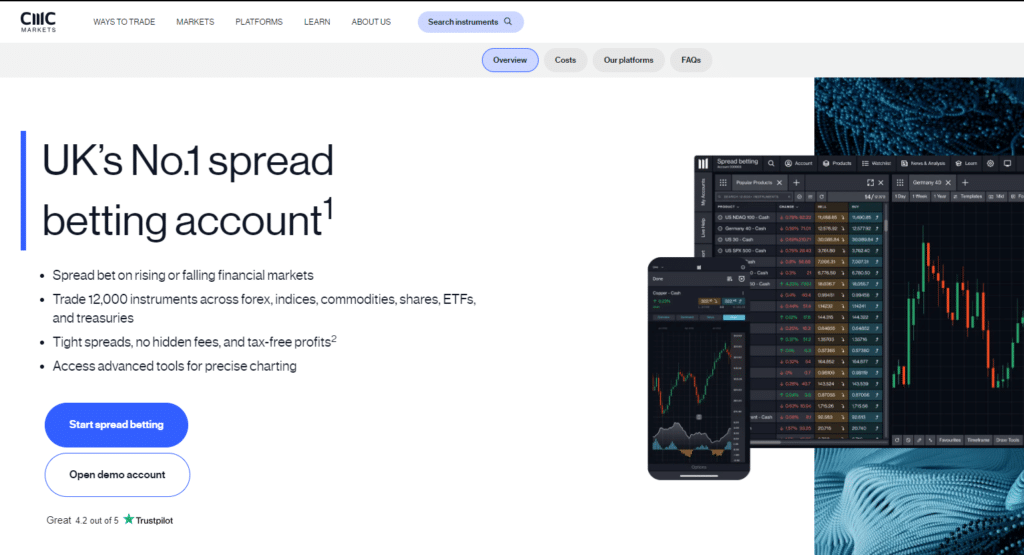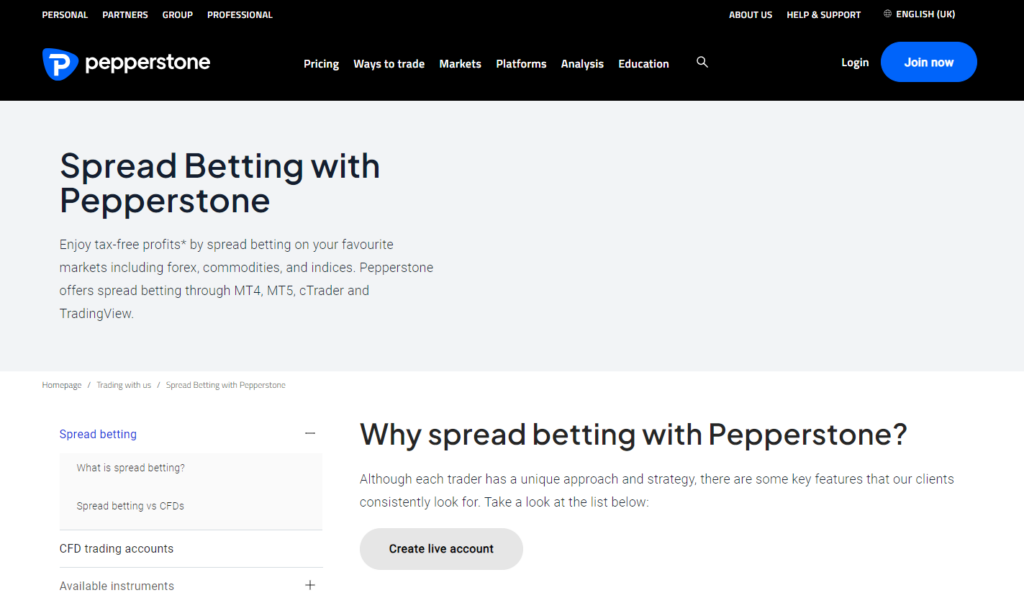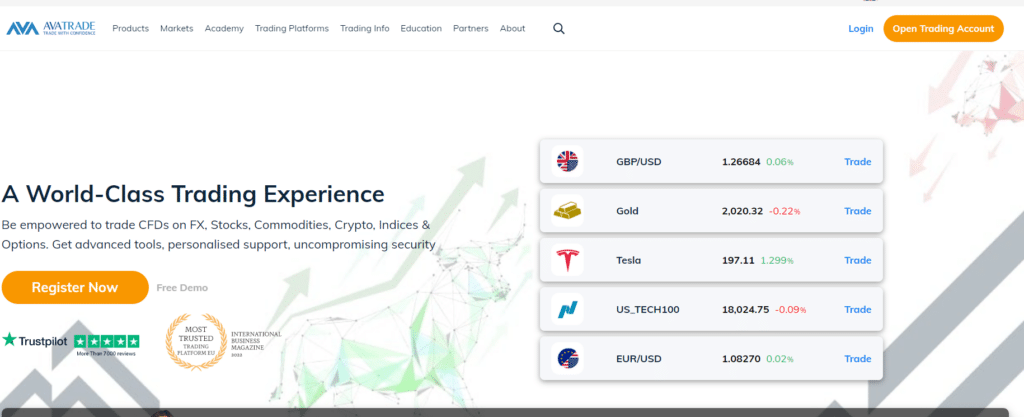Best Spread Betting Platforms in the UK for 2025

Thomas Drury
Co-Founder
Seasoned finance professional with 10+ years' experience. Chartered status holder. Proficient in CFDs, ISAs, and crypto investing. Passionate about helping others achieve financial goals.
Twitter ProfileAuthor Bio

Dom Farnell
Co-Founder
Dom, a Co-Founder at TIC, is an avid investor and experienced blogger who specialises in financial markets and wealth management. He strives to help people make smart investment decisions through clear and engaging content.
Twitter ProfileAuthor Bio
Fact Checked
How we test
At The Investors Centre, we pride ourselves on our rigorous fact-checking process. To delve deeper into our meticulous testing procedures and discover how we ensure accuracy and reliability, visit our dedicated page on how we test.
Risk Warning
Spread bets and CFDs are complex instruments and come with a high risk of losing money rapidly due to leverage. 68-82% of retail investor accounts lose money when trading spread bets and CFDs with this provider. You should consider whether you understand how spread bets and CFDs work, and whether you can afford to take the high risk of losing your money.Last Updated 04/01/2025
Discover our carefully curated selection of trustworthy, regulated spread betting brokers, each thoroughly tested with real capital. All brokers are available to traders in the United Kingdom, providing reliable options for spread betting enthusiasts.
Quick Answer: Who Ranks Top?
In 2025, choosing the best spread betting platform depends on your needs. Spreadex remains a top UK choice, offering diverse markets, competitive spreads, and intuitive web and mobile platforms. It’s designed to suit both beginners and experienced traders, ensuring accessibility and reliability for all levels.
Here are the top 10 spread betting Platforms in the UK:
- Spreadex – Hands down the best overall platform
- IG – Offers an expansive range of markets and robust trading technology for both new and experienced traders.
- CMC Markets – Features an award-winning platform with advanced charting and high-quality research materials.
- Pepperstone – Good for low FX Fees
- AvaTrade – Great Choice for Beginners
- Trade Nation – Easy to use Platform and simple interface
- City Index – Provides powerful trading tools and competitive spreads with a wealth of educational resources.
- Admirals – Offers a diverse array of trading instruments with an emphasis on customer support and education.
- Capital.com – Known for its AI-powered trading insights and transparent pricing model.
- FXCM – Specializes in offering comprehensive trading solutions with strong emphasis on currency and CFD trading
How Do These Spread Betting Brokers Compare?
| Ranking | Broker | Rating | Regulatory Authority | Minimum Deposit | Spread Betting Markets Offered | Platform Usability | Demo Account | Account Types | Spread Costs (EUR/USD) | ||||
|---|---|---|---|---|---|---|---|---|---|---|---|---|---|
| #1 | SpreadEX | 4.9/5 | FCA | £50 | Forex, Indices, Spread Betting | 5 | Yes | Standard, Premium | Varies | ||||
| #2 | IG | 4.8/5 | FCA, ASIC, others | $250 | Forex, Indices, Commodities, Shares, Options | 4.2 | Yes | Standard, Spread Betting | From 0.6 pips | ||||
| #3 | CMC Markets | 4.5/5 | FCA, ASIC | £0 | Forex, Shares, Indices, Commodities | 3.9 | Yes | Standard, Premium, Corporate | From 0.7 pips | ||||
| #4 | Pepperstone | 4.2/5 | ASIC, FCA | $200 | Forex, Indices, Commodities, Shares | 4.5 | Yes | Standard, Razor, Institutional | From 0.0 pips | ||||
| #5 | AvaTrade | 3.9/5 | ASIC, CBI, FSCA, FSA | $100 | Forex, Crypto, Options, Indices, Bonds | 4.6 | Yes | Standard, Spread Betting, Islamic | From 0.9 pips | ||||
| #6 | Trade Nation | 3.9/5 | CySEC | $250 | Forex, Indices, Commodities | 4.5 | Yes | Standard | From 1.0 pip | ||||
| #7 | City Index | 3.5/5 | FCA | £100 | Forex, Indices, Spread Betting | 4.1 | Yes | Standard | From 1 pip | ||||
| #8 | Admirals | 3.5/5 | FCA, ASIC | $20 | Forex, Indices, Shares, Commodities | 4.2 | Yes | Standard, Zero.MT5, Pro | From 0.0 pips | ||||
| #9 | Capital | 3.5/5 | FCA, CySEC | $20 (CFD) | CFDs on Stocks, Indices, Forex, Crypto | 3.8 | Yes | Standard, Invest | From 0.6 pips | ||||
| #10 | FXCM | 3.5/5 | FCA, ASIC | $50 | Forex, Indices, Commodities | 3.8 | Yes | Standard, Active Trader | From 1.2 pips |
10 Best Spread Betting Platforms
Spreadex - Hands down the best overall platform

Spreadex stands out for uniquely offering financial spread betting, providing a versatile platform where users can trade global markets and access a variety of financial instruments from the same account. This integrated approach allows for seamless trading and greater convenience for users.
Pros & Cons
82% of retail investor accounts lose money when trading CFDs with this provider. You should consider whether you can afford to take the high risk of losing your money.
- Unique Offering: Rare blend of financial trading across multiple asset classes.
- Extensive Market Access: Broad selection of financial instruments alongside comprehensive regulatory oversight.
- User-Friendly Interface: Simplified navigation that caters to traders of every exeprince level.
- Tight Spreads: Competitive pricing in both financial that increases chances of profitability.
- Leveraged: No ISA's or non leveraged accounts. Platform designed for trading rather than investment.
- Restricted International Access: Some services are limited to UK and Irish residents.
- Trading Platform: Not compatible with MT4 or MT5, although there is Trading View intergration.
Fees and Costs
| Feature | Spreadex Spread Betting |
|---|---|
| Spread Cost | Built into the quoted price (variable) |
| Commission | None |
| Overnight Financing | Yes (interest charged/credited based on position) |
| Inactivity Fee | No |
| Deposit Fee | No |
| Withdrawal Fee | Free for most methods (charges may apply for international bank transfers) |
IG - Offers an expansive range of markets and robust trading technology for both new and experienced traders.

IG is a leading spread betting platform known for its vast market range and advanced trading technology, catering to both novice and seasoned traders with its comprehensive tools and resources.
Pros & Cons
Spread bets and CFDs are complex instruments and come with a high risk of losing money rapidly due to leverage. 71% of retail investor accounts lose money when trading spread bets and CFDs with this provider. You should consider whether you understand how spread bets and CFDs work, and whether you can afford to take the high risk of losing your money.
- Extensive Market Range: Access to over 17,000 markets including forex, indices, stocks, and commodities.
- Advanced Trading Technology: State-of-the-art platforms and tools for in-depth analysis and trading.
- Educational Resources: Comprehensive learning materials for traders of all levels.
- Superior Customer Support: 24/5 dedicated assistance and account management services.
- Complex Platform for Beginners: The wide array of features may overwhelm new traders.
- Higher Fees on Some Trades: Certain spreads and commissions can be above average.
- Minimum Deposit Requirement: A higher barrier to entry for some traders.
- Account Maintenance Fees: Charges for inactivity and premium services.
Fees and Costs
| Feature | IG Spread Betting |
|---|---|
| Spread Cost | Built into the quoted price (variable) |
| Commission | None |
| Overnight Financing | Yes (interest charged/credited based on position) |
| Inactivity Fee | No |
| Deposit Fee | No |
| Withdrawal Fee | No (currency conversion fees may apply) |
CMC Markets - Features an award-winning platform with advanced charting and high-quality research materials.

CMC Markets is renowned for its award-winning platform online trading, that combines advanced charting capabilities with high-quality research materials, catering to both novice and experienced traders seeking in-depth market analysis and innovative trading tools.
Pros & Cons
70% of retail investor accounts lose money when trading CFDs with this provider. You should consider whether you can afford to take the high risk of losing your money.
- Advanced Charting: Offers over 115 technical indicators and drawing tools for comprehensive market analysis.
- Extensive Research Materials: Provides detailed market insights and trading ideas from industry experts.
- Vast Product Range: Access to more than 10,000 markets including Forex, indices, stocks, and commodities.
- User-Friendly Interface: Designed for ease of use without sacrificing advanced features.
- Complex for Beginners: The plethora of features can be overwhelming for those new to trading.
- Higher Minimum Deposit: The platform may require a larger initial deposit compared to some competitors.
- Account Maintenance Fees: Inactive accounts may incur charges, affecting infrequent traders.
- Limited Customization: While highly functional, the platform has restrictions on layout and tool customization.
Fees and Costs
| Feature | CMC Markets Spread Betting |
|---|---|
| Spread Cost | Built into the quoted price (variable) |
| Commission | None |
| Overnight Financing | Yes (interest charged/credited based on position) |
| Inactivity Fee | No |
| Deposit Fee | No |
| Withdrawal Fee | No (currency conversion fees may apply) |
Pepperstone - Best overall Spread Betting Broker

Pepperstone is highly regarded for its swift execution speeds and broad range of instruments, offering a top-tier spread betting experience with a focus on technology, client support, and market access, making it the best overall choice for traders in the UK.
Pros & Cons
81.7% of retail investor accounts lose money when trading CFDs with this provider. You should consider whether you can afford to take the high risk of losing your money.
- Extensive Market Access: Offers over 150 instruments including Forex, CFDs, and commodities.
- Advanced Platforms: Clients can use MetaTrader 4/5 and cTrader for a comprehensive trading experience.
- Low Costs: Competitive spreads and no commission on spread betting accounts.
- Regulated Broker: Pepperstone is regulated by the FCA, ensuring high standards of security and fair practice.
- Limited Research Tools: Compared to competitors, market analysis and research tools are less extensive.
- Restricted Leverage: Regulatory constraints limit the leverage available to retail clients.
- No Banking License: Pepperstone is not a bank, which might affect perceptions of trust and the range of services.
- Crypto Trading Limitations: Crypto offerings are not as robust as other market categories.
Fees and Costs
| Feature | Standard Account | Razor Account |
|---|---|---|
| Spread Cost | Built into the quoted price (variable) | Tighter spreads (potentially 0 pips) |
| Commission | None | $3.50 per standard lot (round turn) |
| Overnight Financing | Yes (interest charged/credited based on position) | Yes (interest charged/credited based on position) |
| Inactivity Fee | No | No |
| Deposit Fee | Free for most methods | Free for most methods |
| Withdrawal Fee | Free for most methods (AUD 20 for international bank transfers) | Free for most methods (AUD 20 for international bank transfers) |
AvaTrade - Great Choice for Beginners

AvaTrade shines as an exceptional platform for beginners in spread betting, with its user-friendly interface, extensive educational resources, and dedicated support designed to guide new traders through the complexities of financial markets.
Pros & Cons
71% of retail investor accounts lose money when trading CFDs with this provider. You should consider whether you can afford to take the high risk of losing your money.
- User-Friendly Interface: Ideal for beginners with easy navigation and clear instructions.
- Comprehensive Education: Wide array of learning tools, including webinars, e-books, and video tutorials.
- Free Demo Account: Offers a risk-free environment to practice strategies before trading live.
- Global Regulation: Strictly regulated by multiple authorities, providing a secure trading environment.
- Higher Spreads on Some Instruments: Can be more expensive compared to other platforms for certain trades.
- Limited Product Range: While offering a variety of markets, it might not match the breadth of some competitors.
- Inactivity Fees: Charges a fee if the account is not used for an extended period.
- Withdrawal Delays: Some users report slower than average processing times for withdrawals.
Fees and Costs
| Feature | AvaTrade Spread Betting |
|---|---|
| Spread Cost | Built into the quoted price (variable) |
| Commission | None |
| Overnight Financing | Yes (interest charged/credited based on position) |
| Inactivity Fee | Yes ($50 after 3 months of inactivity) |
| Deposit Fee | No |
| Withdrawal Fee | No (currency conversion fees may apply) |

TIC Score 3.9/5
Trade Nation - Easy to use Platform and simple interface

Trade Nation appeals to traders seeking simplicity and ease of use, thanks to its straightforward platform interface and transparent pricing model, making it an attractive option for both new and seasoned traders.
Pros & Cons
81% of retail investor accounts lose money when trading CFDs with this provider. You should consider whether you can afford to take the high risk of losing your money.
- Simple Interface: Streamlined and user-friendly, perfect for beginners.
- Transparent Pricing: Clear, competitive spread costs without hidden fees.
- Customer Support: Exceptional service with access to knowledgeable staff.
- Education Resources: Offers a good selection of learning materials to help traders improve their skills.
- Lesser-known Brand: May not inspire the same level of confidence as more established competitors.
- Narrower Market Range: Compared to larger brokers, the selection of markets can be limited.
- Platform Features: While easy to use, may lack advanced tools sought by experienced traders.
- Mobile App Limitations: The mobile trading experience might not be as robust as other platforms.
Fees and Costs
| Feature | Trade Nation Spread Betting |
|---|---|
| Spread Cost | Fixed spreads starting from 0.4 pips |
| Commission | None |
| Overnight Financing | Yes (interest charged/credited based on position) |
| Inactivity Fee | No |
| Deposit Fee | No |
| Withdrawal Fee | No (currency conversion fees may apply) |

TIC Score 3.5/5
City Index - Provides powerful trading tools and competitive spreads with a wealth of educational resources.

City Index is renowned for offering powerful trading tools, competitive spreads, and a wealth of educational resources, making it a preferred choice for traders seeking a comprehensive trading experience from beginner to advanced levels.
Pros & Cons
69% of retail investor accounts lose money when trading CFDs with this provider. You should consider whether you can afford to take the high risk of losing your money.
- Advanced Trading Tools: High-quality platforms with technical analysis features.
- Wide Market Range: Access to over 12,000 global markets including forex, indices, and shares.
- Competitive Spreads: Low cost of trading across various markets.
- Extensive Educational Materials: Offers a wide range of learning resources to support trader development.
- Account Maintenance Fees: Charges for inactivity can affect traders not frequently trading.
- Complex Platform: Some users may find the advanced platforms intimidating at first.
- Withdrawal Limitations: Certain restrictions and processing times can apply to withdrawals.
- Customer Service Delays: Peak times can lead to slower response rates from support.
Fees and Costs
| Feature | City Index Spread Betting |
|---|---|
| Spread Cost | Built into the quoted price (variable) |
| Commission | None for spread betting (commissions apply for CFD share trading) |
| Overnight Financing | Yes (interest charged/credited based on position) |
| Inactivity Fee | No |
| Deposit Fee | No |
| Withdrawal Fee | 0.5% currency conversion fee for withdrawals in a currency different from your account currency |
Admiral Markets - Offers a diverse array of trading instruments with an emphasis on customer support and education.

Admirals stands out for its comprehensive selection of trading instruments and a strong focus on enhancing trader experience through exceptional customer support and extensive educational offerings.
Pros & Cons
68% of retail investor accounts lose money when trading CFDs with this provider. You should consider whether you can afford to take the high risk of losing your money.
- Wide Range of Instruments: Access to a diverse portfolio of Forex, CFDs, stocks, and commodities.
- Exceptional Customer Support: Dedicated support team available 24/5 with a commitment to quick and helpful responses.
- Rich Educational Resources: Offers a wealth of learning materials, including webinars, seminars, and articles, catering to all levels of traders.
- Advanced Trading Tools: Provides MetaTrader 4 and 5 platforms with custom indicators and analytical tools for a tailored trading experience.
- Account Types: Some traders may find the variety of account types confusing, each with its own set of conditions and benefits.
- Withdrawal Fees: Charges on certain withdrawal methods can add up, especially for small-scale traders.
- Complex Platform Options: The choice between multiple platforms and tools can be overwhelming for beginners.
- Market Spread Variability: While competitive, spreads can widen under volatile market conditions, affecting trade costs.
Fees and Costs
| Feature | Admirals Spread Betting |
|---|---|
| Spread Cost | Built into the quoted price (variable) |
| Commission | None |
| Overnight Financing | Yes (interest charged/credited based on position) |
| Inactivity Fee | Yes (€10 per month after 24 months of inactivity with a positive balance) |
| Deposit Fee | No |
| Withdrawal Fee | 1% currency conversion fee |

TIC Score 3.5/5
Capital.com - Known for its AI-powered trading insights and transparent pricing model.

Capital.com distinguishes itself with AI-powered trading insights that cater to both new and seasoned traders, offering a transparent pricing model that ensures clarity and fairness in trading costs.
Pros & Cons
82% of retail investor accounts lose money when trading CFDs with this provider. You should consider whether you can afford to take the high risk of losing your money.
- AI-Powered Insights: Unique technology provides personalized trading insights, enhancing decision-making.
- Transparent Pricing: Clearly defined costs without hidden fees, making it easier for traders to manage their finances.
- Vast Market Access: Offers a wide range of trading options across stocks, forex, commodities, and cryptocurrencies.
- Robust Educational Resources: Comprehensive learning materials for traders at all levels, including articles, videos, and webinars.
- Limited Advanced Tools: While great for beginners, experienced traders may find the analytical tools insufficient.
- Market Depth Data: Lacks more advanced market depth features that some professionals might require.
- Customer Support: Some users report delays in customer service response times during peak hours.
- Platform Navigation: New users may initially find navigating the extensive features and resources challenging.
Fees and Costs
| Feature | Capital.com CFD Trading |
|---|---|
| Spread Cost | Built into the quoted price (variable) |
| Commission | None |
| Overnight Financing | Yes (interest charged/credited based on position) |
| Inactivity Fee | No |
| Deposit Fee | No |
| Withdrawal Fee | $10 for withdrawals below $250 (free above) |

TIC Score 3.5/5
FXCM - Specializes in offering comprehensive trading solutions with strong emphasis on currency and CFD trading

FXCM is renowned for its focus on providing comprehensive trading solutions professional traders, particularly excelling in currency and CFD trading, catering to a wide spectrum of traders from beginners to seasoned professionals with its array of platforms and tools.
Pros & Cons
66% of retail investor accounts lose money when trading CFDs with this provider. You should consider whether you can afford to take the high risk of losing your money.
- Specialised in Forex: Offers a vast range of currency pairs with competitive spreads.
- Diverse Trading Platforms: Access to Trading Station, MetaTrader 4, NinjaTrader, and ZuluTrade.
- High-Quality Educational Resources: Comprehensive learning materials, including live webinars, seminars, and trading guides.
- Robust Trading Tools: Advanced charting, trading signals, and automated trading options enhance trading efficiency.
- Account Minimums: Higher minimum deposit requirements compared to some competitors.
- Narrower Product Range: Focuses heavily on Forex and CFDs, which might limit options for traders interested in other markets.
- Withdrawal Times: Some users report slower withdrawal processing times.
- Regulatory Restrictions: Geographic restrictions and regulatory changes can impact access to certain markets or leverage ratios.
Fees and Costs
| Feature | FXCM Spread Betting |
|---|---|
| Spread Cost | Built into the quoted price (variable) |
| Commission | None |
| Overnight Financing | Yes (interest charged/credited based on position) |
| Inactivity Fee | $50 after one year of inactivity |
| Deposit Fee | No |
| Withdrawal Fee | No (bank transfer fees may apply) |
Key Considerations for Choosing a Spread Betting Broker
Execution Speed & Technology Integration
Execution speed is crucial for traders employing strategies like day trading or scalping. Fast execution reduces slippage and ensures trades are executed at the intended price. Brokers with strong technology integration, such as support for MetaTrader 4 (MT4) and MetaTrader 5 (MT5), provide traders with sophisticated tools, automated trading capabilities, and enhanced execution speeds. Look for brokers that offer:
- Ultra-low latency execution for faster order processing
- VPS hosting for algorithmic traders
- Direct market access (DMA) for greater transparency
- Integration with advanced trading platforms like MT4, MT5, and cTrader
Market Range Offered by Brokers
A broker’s market range determines the opportunities available to traders. Some brokers focus primarily on forex, while others provide access to indices, commodities, shares, ETFs, cryptocurrencies, and bonds. When choosing a broker, consider:
- Number of available markets (e.g., forex pairs, indices, stocks, commodities)
- Exotic and emerging market instruments
- Availability of leverage on different asset classes
- Depth of liquidity to ensure smooth execution in volatile conditions
Trading Platform Features
The right trading platform can make a significant difference in a trader’s experience. Key platform features to look for include:
- User Interface: A clean, intuitive layout that enhances ease of use
- Charting Tools: Advanced technical indicators, drawing tools, and customizable charts
- Automated Trading: Support for Expert Advisors (EAs) and algorithmic strategies
- Customization: Ability to adjust settings, layouts, and alerts for a personalized trading experience
- Mobile Trading: A robust mobile app for trading on the go
Beginner’s Guide to Spread Betting
What is Spread Betting?
Spread betting is a popular financial derivative that allows traders to speculate on the price movements of a wide range of financial markets, including indices, stocks, currencies, and commodities, without actually owning the underlying asset. This form of trading is particularly attractive due to its tax efficiency in some jurisdictions, like the UK, where profits are free from capital gains tax.
Key Terms to Know:
- Spread: The difference between the buy (ask) and sell (bid) price of an asset.
- Leverage: A tool that allows traders to control a larger position with a smaller amount of capital.
- Margin: The amount of money required to open and maintain a leveraged position.
- Pip: The smallest price movement in forex trading.
- Stop-Loss Order: A risk management tool that closes a position automatically when a predetermined loss level is reached.
How Does Spread Betting Work?
Definition and Overview
At its core, spread betting involves placing a bet on whether the price of an asset will rise or fall. The trader chooses how spread bets on a stake per point movement and profits or loses based on the direction and magnitude of the price movement relative to their bet.
Key Features of Spread Betting
One of the hallmark features of a spread betting account is leverage, which allows traders to gain a large exposure to financial markets with a relatively small capital outlay. However, while leverage can amplify profits, it can also magnify losses. Spread betting also offers the flexibility to go long or short, meaning traders can profit from both rising and falling markets. Additionally, spread betting accounts are usually free from commission charges, with costs instead built into the spread—the difference between the buy and sell prices quoted by the broker.
Comparing Spread Betting to Other Forms of Investment
Spread Betting vs. Stocks
Unlike direct stock investments, where investors buy shares with the aim of selling them at a higher price, spread betting does not involve ownership of the stock. This means traders can speculate on stock price movements without needing significant capital to hold the shares outright. However, it also means traders do not receive dividends or voting rights associated with stock ownership.
Spread Betting vs. Forex Trading
While both spread betting and forex trading involve speculating on currency pair price movements, there are key differences. Forex trading involves buying one currency while selling another in a forex market, often with access to high leverage. In contrast, spread betting on forex is done through a stake per point movement, with profits calculated based on the accuracy of the bet rather than the final market price. Both offer the ability to profit from market movements, but spread betting provides a tax-free advantage in some regions, unlike forex trading which may be subject to capital gains tax.
Educational Resources for Beginners
Understanding spread betting requires solid education. Many brokers offer learning resources to help traders improve their skills and knowledge before committing real money. Educational resources often include:
- Webinars: Live online seminars hosted by trading experts, covering strategies, risk management, and market analysis.
- E-books & Guides: Detailed digital books explaining spread betting principles, strategies, and trading psychology.
- Video Tutorials: Step-by-step visual guides on how to use trading platforms, place trades, and analyze markets.
- Trading Courses: Structured lessons designed to take traders from beginner to advanced levels.
- Market Analysis & Insights: Regular expert commentary and technical analysis to keep traders informed.
Beginners should take advantage of these resources to build confidence and develop a strong foundation before trading with real capital.
The Importance of Demo Accounts
What is a Demo Account?
A demo account is a simulated trading environment that allows users to practice trading with virtual funds. This risk-free setup helps beginners gain hands-on experience and test different strategies without the fear of losing real money.
Benefits of Using a Demo Account:
- Familiarization with Trading Platforms: New traders can explore platform features and tools before trading live.
- Strategy Testing: Traders can experiment with different strategies and risk management techniques in real-market conditions.
- No Financial Risk: Since demo accounts use virtual funds, traders can practice without the risk of losing money.
- Confidence Building: A demo account helps new traders gain experience and develop discipline before transitioning to a real trading environment.
Most top brokers offer demo accounts, often with real-time market data and the same execution speeds as live accounts.
How Does Spread Betting Compare to Regular Trading?
Spread betting is a distinctive form of financial trading that offers unique advantages and differences compared to traditional trading methods. Understanding these differences is crucial for traders to navigate the financial markets effectively.
Key Differences Between Spread Betting and Traditional Trading
Financial Outlay and Margin Requirements
One of the main differences lies in the financial outlay and margin requirements. Spread betting allows for trading on margin, meaning traders can open large positions with a relatively small initial deposit. This leverage makes it possible to maximize potential profits but also increases the very high risk of of significant losses.
Market Access and Instruments
Spread betting provides traders with wide market access from a single platform, including stocks, forex, indices, and commodities, without the need for multiple brokerage accounts. This accessibility to a broad range of financial instruments is a key advantage over traditional trading, where access might be limited based on the brokerage or the type of account.
Risk and Reward Considerations
Leverage and Its Effects
Leverage is a double-edged sword in spread betting, amplifying both gains and losses. While it enables traders to achieve substantial exposure to financial markets with a smaller capital, it can also lead to losses that exceed the initial investment, a scenario less common in traditional trading where leverage is often lower.
Risk Management in Spread Betting
Effective risk management is paramount in spread betting to mitigate the risks associated with leverage and market volatility. Utilizing stop-loss orders, limiting leverage, and employing a disciplined trading strategy are essential practices. Traders must be vigilant in monitoring their positions and market conditions to prevent significant losses.
In conclusion, while spread betting offers the allure of tax benefits, high leverage, and access to a wide range of markets, it also comes with high risks. Traders considering spread betting should understand these key differences and incorporate strict risk management techniques to navigate the complexities of the financial markets successfully.

How to Pick the Best Spread Betting App for your needs
Choosing the right spread betting app can significantly influence your trading experience and success. With numerous options available, focusing on key aspects can help you select an app that meets your trading needs and preferences.
Important Features to Look For
User Interface and Ease of Use
A user-friendly interface is crucial for a seamless trading experience. The best spread betting apps offer intuitive navigation, clear and responsive design, and easy access to essential features such as account management, market data, and trade execution.
Range of Markets and Instruments
The variety of markets and instruments available for trading is another important consideration. Whether you’re interested in forex, stocks, commodities, or indices, the app should provide comprehensive access to a wide range of markets, enabling you to diversify your trading strategies.
Security and Regulation
Licensing and Regulation Checks
Ensuring the spread betting app is licensed and regulated by reputable authorities like the Financial Conduct Authority (FCA) in the UK provides a layer of security and trust. Regulation guarantees that the broker complies with strict financial standards and practices.
Data Security and Protection Measures
Data security is paramount. The app should employ advanced encryption technologies to protect your personal and financial information from unauthorized access. Look for apps that prioritize secure login processes, such as two-factor authentication (2FA).
Comparing Top Spread Betting Apps
Reviews and User Feedback
Reading reviews and feedback from existing users can offer valuable insights into the app’s reliability, functionality, and customer service. Look for consistent patterns in feedback that highlight both strengths and potential issues.
Demo Account Availability and Features
A demo account feature allows you to test the app’s functionality and your trading strategies without risking real money. The best apps offer demo accounts with realistic market conditions, comprehensive tools, and educational resources to enhance your trading skills.
In conclusion, selecting the best spread betting app requires careful consideration of its usability, market access, regulatory compliance, security features, and the availability of demo accounts. Taking the time to research and compare apps based on these criteria will help you find a reliable trading platform that aligns with your trading goals and preferences.
Pros and Cons to Spread Betting
Spread betting is a popular trading mechanism that comes with its unique set of advantages and disadvantages. Understanding these can help traders navigate the complexities of spread betting more effectively.
Advantages of Spread Betting
Tax Efficiency
One of the most appealing aspects of spread betting is its tax efficiency. In many jurisdictions, such as the UK, profits from spread betting are not subject to capital gains tax. This makes it an attractive option for traders looking to maximize their returns without worrying about tax implications on their profits.
Flexibility in Markets
Spread betting offers unparalleled flexibility, allowing traders to speculate on the price movements of a wide array of financial markets, including stocks, forex, commodities, and indices, all from a single account. This ability to spread bet on both rising and falling markets enhances trading opportunities.
Disadvantages of Spread Betting
Risks of Leverage
While leverage can significantly increase potential profits, it also amplifies potential losses. Traders can end up losing more than their initial deposit, making it crucial to use leverage cautiously and understand the risks involved thoroughly.
Potential for Rapid Losses
Spread betting is highly sensitive to market volatility, leading to rapid gains or losses within short periods. This characteristic requires traders to be constantly vigilant, manage their trades actively, and employ effective risk management strategies to mitigate potential losses.
In essence, while spread betting offers tax advantages and the flexibility to trade across various markets, it comes with high risks due to leverage and market volatility. Traders must weigh these pros and cons carefully to determine if spread betting aligns with their trading strategy and risk tolerance.
Is Spread Betting Taxed in the UK?
Spread betting holds a unique position in the UK’s financial landscape, particularly due to its taxation rules. Understanding these can offer significant benefits for traders.
Overview of Spread Betting Taxation
Tax-Free Profits Explained
In the UK, profits from spread betting are not subject to capital gains tax. This is because spread betting is considered a form of gambling under current laws. As a result, any profits you make from spread betting are exempt from tax, making it an attractive option for traders looking to maximize their after-tax returns.
Circumstances Affecting Taxation
While spread betting profits are generally tax-free, certain conditions could affect this status. For example, if the tax authorities determine that spread betting constitutes your primary source of income, you might be subject to different taxation rules. It’s crucial to consult with a tax professional to understand your specific situation fully.
Comparing Tax Implications with Other Investments
Spread Betting vs. Stock Investments
Unlike spread betting, profits from stock investments are subject to capital gains tax if they exceed your annual tax-free allowance. This fundamental difference in tax treatment can significantly affect the net return on investment, making spread betting a potentially more tax-efficient option for some traders.
Capital Gains Tax Considerations
For investors engaging in other forms of trading, such as buying and selling shares, capital gains tax is a crucial consideration. The tax rate depends on various factors, including your total taxable income. In contrast, the tax-free nature of spread betting profits can offer a clear advantage for those looking to trade financial markets without worrying about the impact of capital gains tax on their profits.
In summary, the tax-free status of spread betting profits in the UK makes it an appealing option for many traders. However, it’s important to stay informed about the circumstances that could influence your tax obligations and compare the tax implications with other investment avenues to make the most informed trading decisions.
Is Spread Betting Legal and How is it Regulated?
Spread betting is a recognized and legal form of financial trading in the UK, subject to rigorous regulatory standards aimed at protecting traders and ensuring market integrity.
Legal Status of Spread Betting in the UK
Historical Context and Development
Spread betting originated in the UK in the 1970s, initially as a method for investors to speculate on gold prices without needing to physically own the commodity. Over time, it has evolved into a popular financial activity, encompassing a wide range of markets.
Current Legal Framework
The legal framework governing spread betting in the UK is comprehensive, designed to ensure fair practice and transparency in the industry. Spread betting firms must adhere to strict financial regulations and are overseen by regulatory bodies to operate legally.
Regulation of Spread Betting Platforms
The Role of the Financial Conduct Authority (FCA)
The Financial Conduct Authority (FCA) is the primary regulatory body responsible for overseeing spread betting platforms in the UK. The FCA ensures that these platforms operate within the law, offer fair trading conditions, and provide adequate protection for their clients’ funds and personal information.
Consumer Protection Measures and Compliance
Consumer protection is a cornerstone of the regulatory framework, with measures in place to safeguard traders from unfair practices and financial harm. Spread betting companies and platforms are required to comply with a range of consumer protection standards, including transparent pricing, risk warnings, and access to dispute resolution services.
How to Verify the Legitimacy of a Spread Betting Platform
Checking for FCA Authorization
One of the first steps in verifying the legitimacy of a spread betting platform is to check for FCA authorization. This can be done by searching the FCA’s online register, which lists all financial services firms and individuals authorized by the FCA to operate in the UK.
Understanding Client Money Protection
Client money protection is a key aspect of financial regulation, ensuring that traders’ funds are held separately from the company’s own money. This provides an additional layer of security, as it means that client funds are protected in the event of the company’s insolvency.
In conclusion, the legal and regulatory landscape for spread betting in the UK is designed to create a secure and transparent environment for traders. By understanding these regulations and knowing how to verify the legitimacy of a spread betting platform, traders can navigate the market with confidence.
References
FAQs
The best spread betting brokers are those that offer a combination of competitive spreads, a wide range of markets, advanced trading tools, and robust regulatory compliance. Pepperstone and IG are highly recommended for their comprehensive services and user-friendly trading platforms.
For beginners, AvaTrade and Trade Nation are excellent spread betting platforms due to their intuitive interfaces, extensive educational resources, and dedicated customer support aimed at helping new traders navigate the complexities of spread betting.
Financial spread betting allows traders to speculate on the price movements of financial instruments without owning the underlying asset. It offers tax efficiency as profits are free from capital gains tax in the UK, unlike profits from traditional trading.
Yes, but retail traders with investor accounts face a high risk of losing money rapidly when trading spread bets and CFDs due to leverage. It’s crucial for traders to understand the risks and employ effective risk management strategies.
When starting spread betting, look for accounts that offer low minimum deposits, comprehensive educational resources, demo accounts for practice, and access to a variety of financial markets.
While both facilitate bets on market movements, spread betting brokers specialize in financial spread betting, offering access to financial markets and instruments. Betting brokers typically focus on sports and other non-financial bets.
Many leading spread and betting companies and brokers offer demo accounts that allow you to practice spread betting with virtual funds in a risk-free environment, helping you develop your strategies and understand market dynamics.
A demo account for forex spread betting allows you to familiarize yourself with the forex market’s dynamics, test trading strategies, and gain confidence without risking real capital. It’s an invaluable tool for both beginners and experienced traders looking to refine their techniques.
Featured Blogs
Our Top Featured Spread Betting Brokers
81% of retail investor accounts lose money when trading CFDs with this provider.










